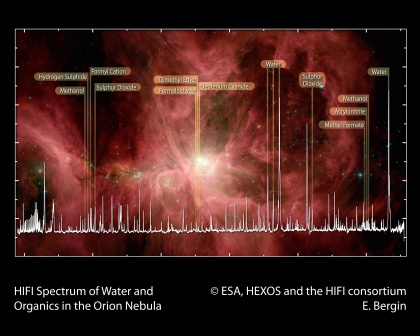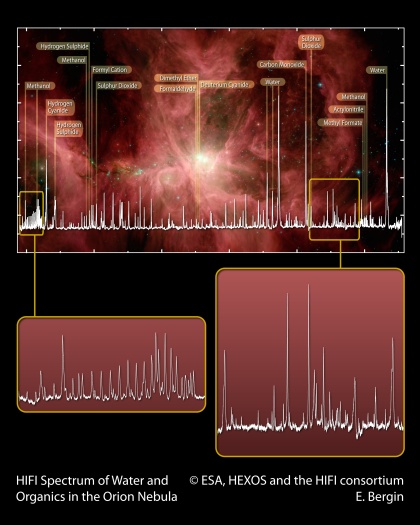Press Release 03/2010 - March 5, 2010
Biomolecules in the Orion Nebula
Herschel's Instrument HIFI, which was partially built at the Max Planck Institute for Solar System Research, has discovered organic molecules in the Orion Nebula.
 ESA's Herschel Space Observatory has revealed fingerprints of potential life-enabling organic molecules in the Orion nebula, one of the nearest regions of stellar birth in our Milky Way galaxy.
ESA's Herschel Space Observatory has revealed fingerprints of potential life-enabling organic molecules in the Orion nebula, one of the nearest regions of stellar birth in our Milky Way galaxy.  Herschel's Heterodyne Instrument for the Far Infrared (HIFI) which has partly been developed and built at the Max Planck Institute for Solar System Research (MPS), the Max Planck Institute for Radioastronomy and the University of Cologne in Germany recently obtained the most detailed spectrum, or chemical fingerprint, in this nebula. The HIFI-spectrum, and the many more to come, will provide a treasure trove of information on how organics form in space.
Herschel's Heterodyne Instrument for the Far Infrared (HIFI) which has partly been developed and built at the Max Planck Institute for Solar System Research (MPS), the Max Planck Institute for Radioastronomy and the University of Cologne in Germany recently obtained the most detailed spectrum, or chemical fingerprint, in this nebula. The HIFI-spectrum, and the many more to come, will provide a treasure trove of information on how organics form in space.
Striking features in the HIFI spectrum include a rich, dense pattern of "spikes”. Each of these spikes represents emission of light from a specific molecule in the Orion Nebula. This nebula is known to be one of the most prolific chemical factories in space, although the full extent of its chemistry and the pathways for molecular formation are not well understood. By sifting through the pattern of spikes in the Orion spectrum, astronomers have identified a few common molecules that appear everywhere in the spectrum. The identification of the many other emission lines is currently ongoing.

|
The HIFI spectrum of the Orion Nebula, seen against a Spitzer image of Orion: Among the identified organic molecules are water, carbon monoxide, formaldehyde, methanol, dimethyl ether, hydrogen cyanide, sulphur oxide, sulphur dioxide and their isotope analogs.
|
Image: ESA, HEXOS & HIFI consortium (E. Bergin).
|
By clearly identifying the lines associated with the more common molecules, astronomers can then begin to tease out the signature of particularly interesting molecules that are the direct precursors to life-enabling molecules. A characteristic feature of the Orion spectrum is the spectral richness: among the organic molecules that can be identified in this spectrum are water, carbon monoxide, formaldehyde, methanol, dimethyl ether, hydrogen cyanide, sulphur oxide, sulphur dioxide and their isotope analogs. It is expected that new organic molecules will also be identified.
"The HIFI spectrum, and the many more to come, will provide a virtual treasure trove of information regarding the overall chemical inventory and on how organics form in a region of active star formation. It harbours the promise of a deep understanding of the chemistry of space once we have the full spectral surveys available”, said Edwin Bergin of the University of Michigan, principal investigator of the HEXOS Key Programme on Herschel.
HIFI was designed to provide extremely high-resolution spectra and to open new wavelength ranges for investigation, which are inaccessible to ground-based telescopes. "It is astonishing to see how well HIFI works," said Frank Helmich, HIFI principal investigator of SRON Netherlands Institute for Space Research. "We obtained this spectrum in a few hours and it already beats any other spectrum at any other wavelength ever taken of Orion. Organics are everywhere in this spectrum, even at the lowest levels, which hints at the fidelity of HIFI. The development of HIFI took eight years but it was really worth waiting for.”

|
The HIFI spectrum of the Orion Nebula, seen against a Spitzer image of Orion: Among the identified organic molecules are water, carbon monoxide, formaldehyde, methanol, dimethyl ether, hydrogen cyanide, sulphur oxide, sulphur dioxide and their isotope analogs.
|
Image: ESA, HEXOS & HIFI consortium (E. Bergin).
|
The spectrum was obtained in February 2010. Herschel is a European Space Agency (ESA) Cornerstone Mission, with science instruments provided by consortia of European institutes and NASA. One of the three instruments is HIFI ("Heterodyne Instrument for the Far-Infrared"), an extremely sensitive spectrometer for observations in the far-infrared. Germany contributes to HIFI with several core components. The local oscillator, built at the Max Planck Institute for Radioastronomy in Bonn, and superconducting detectors with sensitivities close to the fundamental quantum limit, such as the ones contributed by Cologne University, transforms the heterodyne mixing technique known from classical radio frequencies by four orders of magnitude to the far-infrared regime of the electromagnetic spectrum. Another core component of HIFI, its acousto-optical spectrometer (AOS), was built by Cologne University in collaboration with MPS in Katlenburg-Lindau. Altogether, HIFI was realized as a collaboration of 25 institutes from 13 different countries, led by SRON (Groningen, The Netherlands).
Kontakt
Dr. Birgit Krummheuer
Presse- und Öffentlichkeitsarbeit
Max Planck Institute for Solar System Research
Katlenburg-Lindau, Germany
Tel.: +49 5556 979 462
Email: krummheuer mps.mpg.de
mps.mpg.de
Dr. Norbert Krupp
Presse- und Öffentlichkeitsarbeit
Max Planck Institute for Solar System Research
Katlenburg-Lindau, Germany
Tel: +49 5556 979 154
Email: krupp mps.mpg.de
mps.mpg.de
Dr. Paul Hartogh
Max Planck Institute for Solar System Research
Katlenburg-Lindau, Germany
Tel: +49 5556 979 342
Email: hartogh mps.mpg.de
mps.mpg.de
